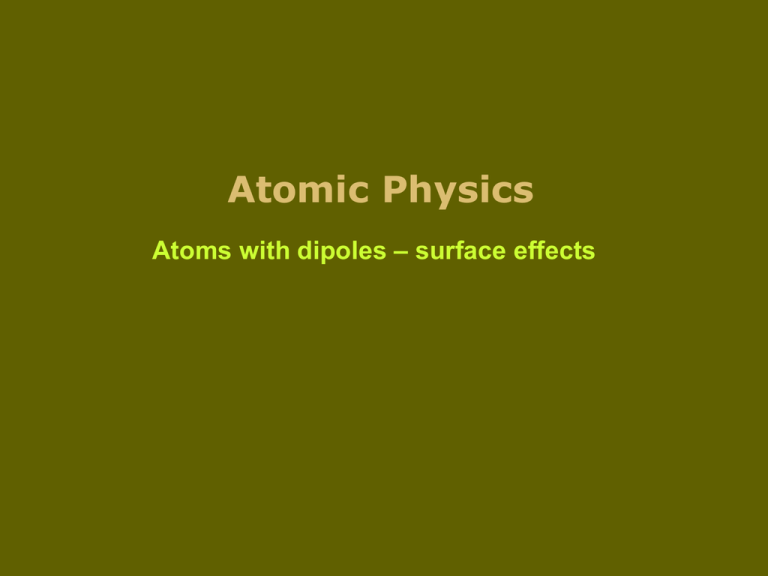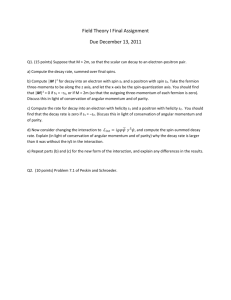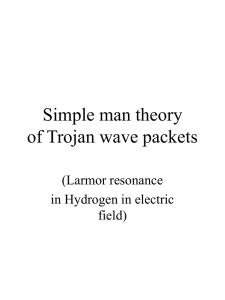Quantum beats
advertisement

Atomic Physics Atoms with dipoles – surface effects Any sort of collision … 1. Ion Velocity: E/mc2 = E(MeV)/0.5(MeV) = ½ MN v2 / mc2 Therefore v/c = √ [ 4E(MeV) (m/MN)] = ( 2/√1840 ) √[(E (MeV)/A(amu)] Giving v = 13.9 mm/ns √[(E (MeV)/A(amu)] Note: 2. c = 300 mm/ns Atomic velocity (from Bohr theory): Quantum number n, nuclear charge Z, Vn = (2πe2/ħ) (Z/n) = v0 (Z/n) Where v0 = velocity of 1st Bohr orbit = c/137 Van de Graaff accelerators The GSI – Darmstadt accelerators Fluorescence in an Electric field 1st fast-beam experiment - a little complicated… Fixed E-field Variable magnetic field Fluorescence in an Electric field Incident protons pick up electrons in the target into excited states – consider just the n=2 states.. Apply an electric or magnetic field after the target and measure Lyman-α emission: What happens? Stark effect in atoms (in brief) For an electric field E(z) in the z-direction, the first order stark energy correction is ΔWE(1) = eE <ψ| z |ψ> However, if the state |ψ> has a definite parity (+ or -), this integral is zero. Hence, we need to use the second order expression: 1st case The Quadratic Stark effect: ΔWE(2) = e2E2 ∑(γ′J′) |<γJMJ | z |γ′J′MJ>|2 /[WγJ - Wγ′J′ ] Notes: (1) the coupled states must have opposite parity and have the same MJ. (2) We have the selection rule J′ = J ± 1 (or L′ = L ± 1 and S=S′ in LS-coupling. (3) The energies are proportional to (MJ)2 2nd case: the “linear” Stark effect: when states of opposite parity are degenerate or closely degenerate – (almost only hydrogen), we can set up a secular equation – the diagonal elements will be zero [see case (1)] , while the off-diagonal terms will be the Stark coupling elements. Stark effect in atoms (2) Consider 2 states a and b – eg the 2s1/2 and 2p1/2 states in hydrogen which are almost degenerate except for the Lamb shift L. In an electric field E ...... The perturbed energies W(E)a and W(E)b will be the solutions of the determinant: | W(E)aa – L -W W(E)ab | =0 | W(E)ba W(E)bb – W | Where the 2 diagonal elements W(E)aa and W(E)bb are zero And the 2 off-diagonal elements are equal: W(E)ab = W(E)ba = -3ea0Z E Ignoring L, we get the solutions W = ± 3ea0Z E => a linear variation for the 2 ML = 0 states, and NO variation for the 2p, ML= ±1 states For very small electric fields where 3ea0Z E is comparable or smaller than L, we will see a quadratic dependence [Homework: solve above equation for these two states when the field splitting 3ea0Z E = L Note: the 2 ML=0 wavefunctions are also mixtures of the field-free 2s and 2p states: Show that: ψ(E)1 = α ψ(0)1 + βψ(0)2 ψ(E)2 = α ψ(0)2 - βψ(0)1 Where α and β mixings are dependent on the field E.] Electric fields - dipoles Incident protons pick up electrons in the target into excited states – consider just the n=2 states. Apply an electric or magnetic field after the target. Try the Stark effect ideas.. Observed decay of Lyman-α in external electric and magnetic fields Decay of Lyman-α in an external electric field, showing the higher frequency J=1/2-3/2 quantum beats. The lower curve is the difference of measurements in the 2 E-field directions, the top curve shows the summed decay. Mixing of opposite parity Example of the n=2 s-states and p-states of hydrogen Notes: 1. Time dependent wavefunctions. 2. Non-definite parity states! 3. Electric field mixing. 4. Decay modes. The Eck effect The effect of reversing the direction of the electric field seen by the hydrogen atom as it leaves the target… Explain the second graph!... The Eck theory of atoms having an electric dipole - PRL 31, 270 (73) 2s-state 2p state The quantum beat amplitudes depend on the phase angle α between the s and p excitation amplitudes fs and fp0, and the cross-sections. With no coherence, the amplitude and phase of the beats are the same (only the V2 term is nonzero). Eck’s result is given below: From the data one can determine that the <center> of the electron cloud is not at the proton, but can be in front or behind the proton. Further measurements show that the electron cloud tends to be in front of the proton as it exits the surface, but there is a significant energy-dependence of this feature – not yet explained. Deuterium Balmer-alpha decay – note the electric field plates Density matrix formalism for quantum beats (useful for describing photon decays of coherent states…) Define the wavefunction as: And the density matrix parameters ρ where the energies are complex (including the decay constant γ) as defined above Note: Diagonal terms In general Off-diagonal terms Removing cylindrical symmetry Since the hydrogen experiment indicates that electron pick-up at the final surface is important, what are the important symmetries in the atomic wavefunctions? What happens if we tilt the surface, and remove “cylindrical symmetry” in the excitation system? What happens in the decay processes for such wavefunctions? We need to understand the links between such wavefunctions (e.g. their angular momentum properties) and the optical polarization properties of the light emitted.








